Friday, February 25, 2022 | Written by Claire
Blue. That was all I could see for miles. Perched upon a sea kayak along the Benagil Coast in Lagos, Portugal, I paddled with all my might against the roaring waves that trailed behind the wake of a passing speed boat. To my right was an endless stretch of glistening turquoise waters, while to my left, giant white cliffs loomed into the sky. As the sound of the waves crashing against the rocks grew louder, so did the sound of hundreds of seagulls and pigeons, circling above a giant chasm of rocky shores. The Benagil Caves is a sight that everyone must see at least once in their lives. Not only does the crisp, clean, water hold such depth and color, the caves themselves are canvases of natural forces carved out in circular patterns over millions of years.
At the Benagil Shore in Portugual, there are things fit for everyone who wants to see its pristine beauty. For those looking for a more relaxed activity, sunbathing or swimming along the coast is always an option. Sands in Portugual are more rusty-colored and coarse when compared to the white-sand beaches, but they’re clean and toasty, just enough for you to get a tan. 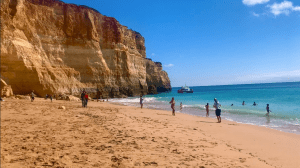 For those looking for better views off the shore with minimal effort, taking one of their boat tours is the best option. They have speed boat tours every hour and in small groups, they take you on a cruise through caves and water holes where people normally wouldn’t be able to swim to. While you might get a splash here or there, you might be able to spot a whale or two on your excursion and you’ll be returning with a camera roll full of beautiful pictures and great memories for sure.
For those looking for better views off the shore with minimal effort, taking one of their boat tours is the best option. They have speed boat tours every hour and in small groups, they take you on a cruise through caves and water holes where people normally wouldn’t be able to swim to. While you might get a splash here or there, you might be able to spot a whale or two on your excursion and you’ll be returning with a camera roll full of beautiful pictures and great memories for sure.
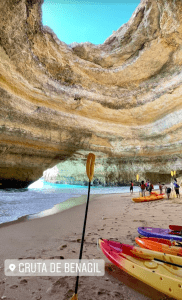 If you want an up close and personal look at caves, go sea kayaking with a guided tour. Those people can help you get to certain landmarks such as the crocodile rock while telling you stories about how the rocks formed. Not only do these tour guides help you dock your kayaks, but they’ll also help you get back on board in case you flip! Sea Kayaking is a great way to be immersed in the natural beauty while paddling close to the water without getting drenched in the cold waters during the winter. You’ll get an adrenaline rush from racing through the waves and get a waft of cool, ocean breeze while basking in the warmth of the sunlight.
If you want an up close and personal look at caves, go sea kayaking with a guided tour. Those people can help you get to certain landmarks such as the crocodile rock while telling you stories about how the rocks formed. Not only do these tour guides help you dock your kayaks, but they’ll also help you get back on board in case you flip! Sea Kayaking is a great way to be immersed in the natural beauty while paddling close to the water without getting drenched in the cold waters during the winter. You’ll get an adrenaline rush from racing through the waves and get a waft of cool, ocean breeze while basking in the warmth of the sunlight.
Finally, for the ultimate adrenaline rush and to fuel your love for speed, you can go mountain biking across the southern coast where you can ride along the top of the cliffs and get a stunning aerial view. There are trials for experienced and non-experienced riders of all ages and rental companies are super accommodating. If you’re going during the summer, make sure you have a reservation as tourism in Lagos will skyrocket. Mountain biking will give your legs a workout for sure, but the ups and downs of the coastal trails will get you flying out of your seat at times, so be careful! If you’re worried about getting lost, they also have many guided tours as well. But if not, don’t fret. There is a special app where you can load a pre-marked trail onto your phone so all you do is just follow along the path and then you’ll end up where you started, safe and sound. Each bike also comes with repair kits, locks, helmets, and tire pumps just in case you get a flat tire along the road, so you’re well prepared to face whatever comes your way! 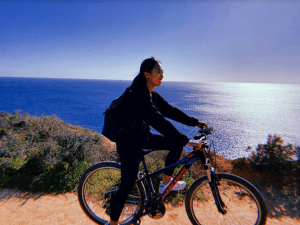


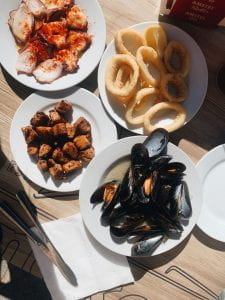
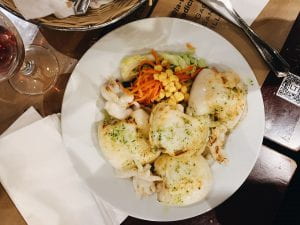
 The skies were a baby pink and pastel blue when we reached the Notre-Dame de la Garde, perched upon a hill overlooking the city. The view was breath-taking. The clear blue waters of the Mediterranean melted into the gentle hues of the sky to create a glowing aura across the land. Against the beautiful backdrop, the city started to wake from its slumber as people slowly filled the streets, each claiming a pastry for a quick breakfast. The random collection of buildings, homes, and even soccer fields created an interesting puzzle of red roofs, white columns, and green patches of land. As I stood along an overlook, I took a deep breath of crisp morning air just as the church clock began to strike. The sound of the resounding gongs and the squawking birds paired with the stunning view and peaceful scenery painted the ideal picture of Marseille into my memory, one so different from any others.
The skies were a baby pink and pastel blue when we reached the Notre-Dame de la Garde, perched upon a hill overlooking the city. The view was breath-taking. The clear blue waters of the Mediterranean melted into the gentle hues of the sky to create a glowing aura across the land. Against the beautiful backdrop, the city started to wake from its slumber as people slowly filled the streets, each claiming a pastry for a quick breakfast. The random collection of buildings, homes, and even soccer fields created an interesting puzzle of red roofs, white columns, and green patches of land. As I stood along an overlook, I took a deep breath of crisp morning air just as the church clock began to strike. The sound of the resounding gongs and the squawking birds paired with the stunning view and peaceful scenery painted the ideal picture of Marseille into my memory, one so different from any others. 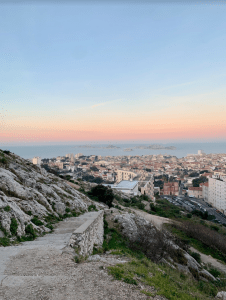

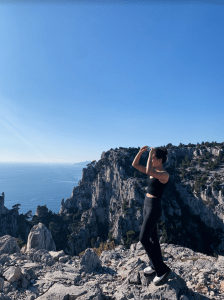
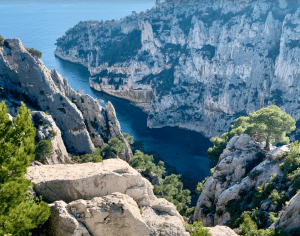
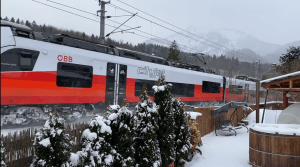
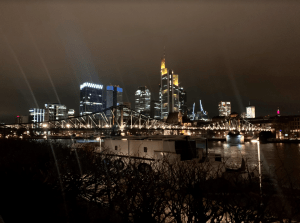
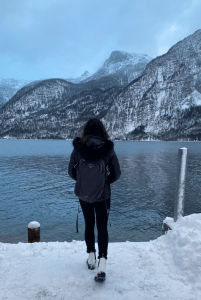 It was the sound of the snow crunching under my boots, the whistle of the wind, and the rustle of the everlasting pines that engulfed me into a magical world. It seemed as if every small movement brought a tingle to my ears as I tried to search for the source of the sound. Here and there, the rumble of a car engine and the scrape of a shovel pierced the still air; however, it still seemed to be an art within itself. It was as if nature and humanity met at a crossroad, blending into a circle of life. The sounds, so mundane yet so foreign, seemed to hold such deeper meaning in a place so different from home.
It was the sound of the snow crunching under my boots, the whistle of the wind, and the rustle of the everlasting pines that engulfed me into a magical world. It seemed as if every small movement brought a tingle to my ears as I tried to search for the source of the sound. Here and there, the rumble of a car engine and the scrape of a shovel pierced the still air; however, it still seemed to be an art within itself. It was as if nature and humanity met at a crossroad, blending into a circle of life. The sounds, so mundane yet so foreign, seemed to hold such deeper meaning in a place so different from home. 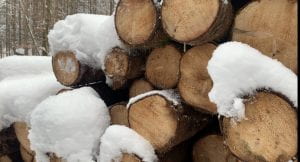 It was the fresh smell of timber that wafted through the air as we continued to trek into the forest. Logs upon logs of wood lay in a pile under a light blanket of snow, as if it were to contain the comforting aroma. Upon first glance, it was just like any ordinary sight; however, as I stepped closer, I could smell an earthy sweetness, a deep scent of cedar and pine that engulfed the pile of wood. It instantly brought me a vision of a log cabin, warmed by a crackling fireplace, hidden away from others for miles. It reminded me of Christmas, but this time in a winter wonderland.
It was the fresh smell of timber that wafted through the air as we continued to trek into the forest. Logs upon logs of wood lay in a pile under a light blanket of snow, as if it were to contain the comforting aroma. Upon first glance, it was just like any ordinary sight; however, as I stepped closer, I could smell an earthy sweetness, a deep scent of cedar and pine that engulfed the pile of wood. It instantly brought me a vision of a log cabin, warmed by a crackling fireplace, hidden away from others for miles. It reminded me of Christmas, but this time in a winter wonderland. 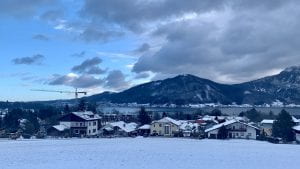
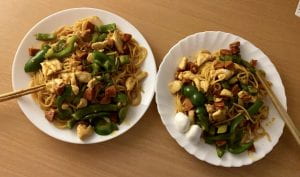 To maintain a balanced diet, I often head back to Lafayette and cook up my own pasta meal. Throwing together some mushrooms, green peppers, sausage, steak, and some spices, spaghetti chow mien is my go-to. Not only is it flavorful, but it is also easy to make, with the pasta taking the longest to boil. All the ingredients can be easily bought at CORA at your convenience.
To maintain a balanced diet, I often head back to Lafayette and cook up my own pasta meal. Throwing together some mushrooms, green peppers, sausage, steak, and some spices, spaghetti chow mien is my go-to. Not only is it flavorful, but it is also easy to make, with the pasta taking the longest to boil. All the ingredients can be easily bought at CORA at your convenience. 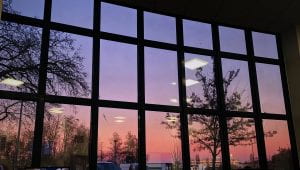
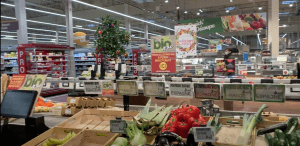 After dinner on Mondays, I tend to take a trip to Cora for some groceries. If you’re in the fast-food mood, you might as well grab dinner down there before heading to the market. GTL provides a free shuttle back to the dorms from Cora on Mondays so it’ll make your life easier than lugging jugs of milk back a mile back to Lafayette.
After dinner on Mondays, I tend to take a trip to Cora for some groceries. If you’re in the fast-food mood, you might as well grab dinner down there before heading to the market. GTL provides a free shuttle back to the dorms from Cora on Mondays so it’ll make your life easier than lugging jugs of milk back a mile back to Lafayette. 
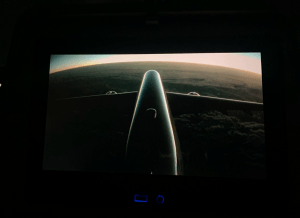
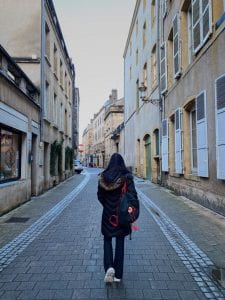 Being downtown during the first Saturday of the semester opened my eyes to an entire world of French traditions. It was as if my Youtube Screen had come to life. The architecture featured huge stone structures, quaint city stores, and bustling alleyways that became home to people drinking coffee, chatting, and listening to ‘Bella Ciao’ as the sun began to dip below the horizon. Castles and stores along the river became a beautiful blend of modern and ancient France, a reminder of the rich history within Metz. The food offered an even greater variety. The streets were lined with dozens of pastry stores featuring chocolate dipped croissants, king cake, and even powdered buns while the heart of downtown Metz boasted a mix of Italian, Turkish, and even Chinese food. Finally, the people who frequented the town upheld strong French values, sticking to their language and cultural norms. The sleek, chic style of long coats, scarves, and leather shoes were common defenses against the cold. For those working in restaurants, they always greeted us with a “Bonjour” and a smile on their faces.
Being downtown during the first Saturday of the semester opened my eyes to an entire world of French traditions. It was as if my Youtube Screen had come to life. The architecture featured huge stone structures, quaint city stores, and bustling alleyways that became home to people drinking coffee, chatting, and listening to ‘Bella Ciao’ as the sun began to dip below the horizon. Castles and stores along the river became a beautiful blend of modern and ancient France, a reminder of the rich history within Metz. The food offered an even greater variety. The streets were lined with dozens of pastry stores featuring chocolate dipped croissants, king cake, and even powdered buns while the heart of downtown Metz boasted a mix of Italian, Turkish, and even Chinese food. Finally, the people who frequented the town upheld strong French values, sticking to their language and cultural norms. The sleek, chic style of long coats, scarves, and leather shoes were common defenses against the cold. For those working in restaurants, they always greeted us with a “Bonjour” and a smile on their faces.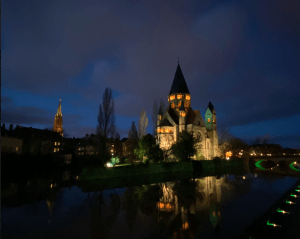
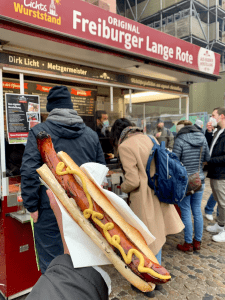


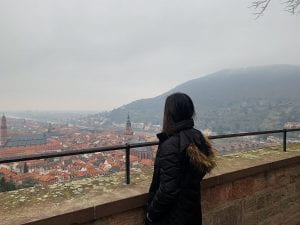 If you ever find yourself looking for a convenient place to go for a weekend, definitely hit up Freiburg and Heidelberg. Although the journey there was a bit chaotic, the experiences and delicious foods we tried in Germany were unforgettable. Overall, a 10/10 way to start my semester at GTL.
If you ever find yourself looking for a convenient place to go for a weekend, definitely hit up Freiburg and Heidelberg. Although the journey there was a bit chaotic, the experiences and delicious foods we tried in Germany were unforgettable. Overall, a 10/10 way to start my semester at GTL.